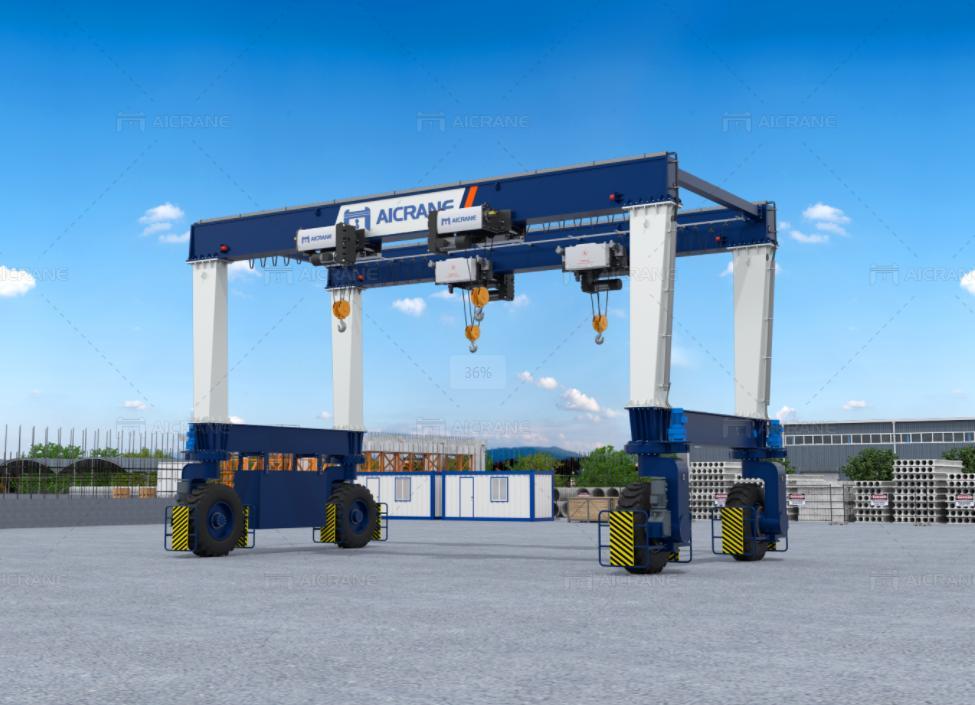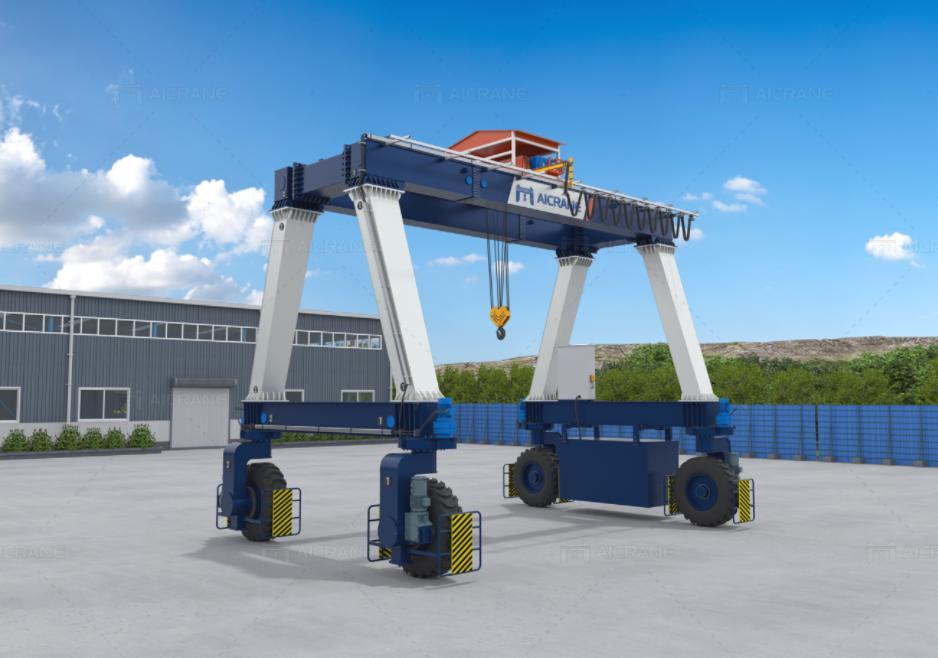Rubber Tyred Gantry (RTG) cranes have become a fundamental part of the modern logistics and port industries, providing flexible and efficient solutions for container handling. These cranes are particularly beneficial in environments where mobility and versatility are critical. They are capable of moving freely along tracks or designated paths without the need for a fixed foundation, making them ideal for port terminals, warehouses, and construction sites. As industries demand higher efficiency and performance, the design of RTG crane frames has seen significant innovations in recent years.
In this article, we will explore some of the latest innovations in rubber tyred gantry crane frame design, focusing on the materials used, structural enhancements, and technological advancements that are shaping the future of these essential machines.

1. Lightweight and High-Strength Materials
One of the most significant innovations in RTG crane frame design has been the development and incorporation of lightweight, high-strength materials. Traditionally, crane frames were made of heavy steel, which, while strong, added substantial weight to the crane. This weight impacts not only the mobility of the crane but also its fuel consumption and overall efficiency.
Recent advancements in material science have led to the development of advanced steel alloys and composite materials that offer a higher strength-to-weight ratio. These materials are designed to withstand the intense forces and stresses exerted on crane frames during lifting and transportation, while reducing the overall weight of the crane. As a result, the crane becomes more fuel-efficient, requiring less power to operate, and it can also handle heavier loads without compromising stability.
Some manufacturers have also started experimenting with aluminum alloys in non-structural parts of the crane, further reducing weight without sacrificing performance. The use of these lightweight materials has enabled RTG cranes to achieve greater lifting capacities and improved maneuverability.
2. Modular and Flexible Frame Designs
The increasing demand for customizable and scalable RTG cranes has driven the trend toward modular frame designs. Modular RTG cranes offer the advantage of flexibility, allowing the crane frame to be easily adapted to different operational needs and environmental conditions. The ability to configure the frame in a modular fashion also allows for easier repairs and maintenance.
Modular frame designs typically consist of pre-fabricated components that can be assembled on-site. These components can include base frames, wheel structures, cross beams, and lifting gloves, all of which can be interchanged or upgraded as needed. For example, if a port terminal needs to increase the lifting capacity of its RTG cranes, additional components can be added to the existing frame, such as larger lifting arms or more robust wheel systems, without requiring a complete overhaul of the machine.
Furthermore, the modular approach allows manufacturers to offer customizable RTG cranes that can be tailored to meet specific operational requirements, such as different container sizes, lifting heights, or travel distances. This flexibility is crucial in environments where container handling needs can vary greatly.
3.Enhanced Stability and Safety Features
As RTG cranes are used in environments that often involve uneven ground conditions and variable weather, ensuring stability is paramount. Recent innovations in frame design have focused on improving crane stability, especially during lifting operations.
One such innovation is the development of advanced anti-sway systems that work in tandem with the crane's frame structure. These systems help to reduce the swinging motion of the load, ensuring that the crane remains stable and that the load is safely and precisely positioned. Anti-sway technologies are integrated into the crane frame through sophisticated sensors and control systems, which monitor the crane's movement in real-time and adjust the crane's actions to minimize sway.
Additionally, improvements in the wheel and axle design have contributed to the stability of RTG cranes. Modern RTG cranes feature advanced wheel systems with high-torque motors, which distribute the load more evenly and reduce the stress on individual wheel assemblies. This not only improves the crane's stability but also enhances its longevity, as the load is shared across more points of contact.
Some cranes also incorporate a load-sensing system in the frame, which helps operators determine if the mobile gantry crane is lifting a load that exceeds its designed capacity. If the crane is overloaded, the system will trigger a warning or automatically adjust the lifting speed to prevent damage to the crane or injury to workers.
4. Smart Crane Frame Technology and Automation
Incorporating smart technologies into the frame design has been one of the most transformative innovations in RTG crane development. Smart technologies have the potential to improve the efficiency, safety, and overall performance of RTG cranes by providing real-time data about the crane's operation and condition.
For example, modern RTG cranes are now equipped with IoT sensors embedded within the frame. These sensors monitor critical aspects of the crane's performance, including load weight, wheel wear, engine temperature, and hydraulic pressure. This data is transmitted to a central control system, where it can be analyzed to detect any potential issues before they become serious problems. Predictive maintenance models, driven by this data, enable operators to carry out repairs and maintenance only when necessary, reducing downtime and operating costs.
Another exciting development is the use of automation in RTG cranes. Fully autonomous RTG cranes are now being tested and deployed in ports around the world. These cranes are designed to move containers and perform lifting operations without human intervention. The frame of these cranes is equipped with a suite of sensors and cameras that allow the crane to navigate the terminal and interact with other machinery autonomously. This innovation has the potential to revolutionize the port industry by increasing efficiency and reducing human errors.

5. Energy-Efficient Designs
As the global focus on sustainability and energy conservation intensifies, energy-efficient designs have become a key consideration in RTG crane frame development. The modern RTG crane is expected not only to perform efficiently but also to minimize its environmental impact.
One of the key innovations in energy efficiency is the integration of hybrid or fully electric power systems. Traditionally, RTG cranes relied on diesel engines, which contributed to high fuel consumption and emissions. However, newer models now feature hybrid engines that combine diesel with electric motors, allowing the crane to switch between fuel types depending on the task. For example, during low-load operations, the crane may rely solely on electric power, reducing fuel consumption and emissions.
Electric RTG cranes have also seen improvements in their frame design to accommodate high-voltage batteries and power management systems. These cranes can be charged via an overhead power supply or through a battery swapping system, further reducing their environmental footprint. This shift toward electric power not only contributes to sustainability but also reduces operating costs over the long term.
6. Corrosion-Resistant Frame Coatings
The exposure of RTG cranes to harsh environmental conditions—such as saltwater, extreme temperatures, and heavy rainfall—can cause corrosion over time. To combat this, manufacturers have introduced advanced corrosion-resistant coatings for crane frames.
These coatings are designed to protect the metal components of the crane from rust and deterioration, extending the crane's lifespan and reducing the need for frequent maintenance. Innovations in this area have led to the development of coatings that not only resist corrosion but also enhance the crane's aesthetic appearance, making them more durable and attractive for long-term use.
Conclusion
Innovations in Rubber Tyred Gantry crane frame design have dramatically improved their performance, safety, and efficiency. The introduction of lightweight materials, modular designs, enhanced stability features, smart technology, energy-efficient systems, and corrosion-resistant coatings has positioned RTG cranes as a cornerstone of modern container handling. These innovations are not only addressing the growing demand for higher capacity and performance but are also helping to ensure that RTG cranes meet the evolving needs of the global logistics and port industries in a sustainable and cost-effective manner.
As the industry continues to innovate, it's clear that the future of RTG cranes will be defined by smarter, more efficient, and environmentally friendly designs. Manufacturers who embrace these advancements will be well-positioned to meet the needs of an increasingly competitive and eco-conscious market.